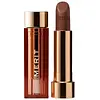Revolution Beauty New Neutral Satin Matte Lipstick Versus Merit Beauty Signature Lip Lightweight Lipstick
What's inside
What's inside
 Key Ingredients
Key Ingredients

 Benefits
Benefits

 Concerns
Concerns

No concerns
 Ingredients Side-by-side
Ingredients Side-by-side

Isononyl Isononanoate
EmollientAluminum Starch Octenylsuccinate
AbsorbentPolyethylene
AbrasiveCeresin
Emulsion StabilisingHydrogenated Microcrystalline Wax
Emulsion StabilisingDiisostearyl Malate
EmollientCamellia Oleifera Seed Oil
Skin ConditioningTocopheryl Acetate
AntioxidantPhenoxyethanol
PreservativeAroma
CI 77891
Cosmetic ColorantCI 77491
Cosmetic ColorantIron Oxides
CI 77492
Cosmetic ColorantCI 77499
Cosmetic ColorantCI 15850
Cosmetic ColorantCI 42090
Cosmetic ColorantCI 19140
Cosmetic ColorantRicinus Communis Seed Oil
MaskingIsostearyl Isostearate
EmollientCaprylic/Capric Triglyceride
MaskingDimer Dilinoleyl Dimer Dilinoleate
EmollientTribehenin
EmollientC10-18 Triglycerides
EmollientPolyethylene
AbrasiveBis-Diglyceryl Polyacyladipate-2
EmollientHelianthus Annuus Seed Cera
EmollientHelianthus Annuus Seed Wax
Skin ConditioningCopernicia Cerifera Wax
Carica Papaya Fruit Extract
Skin ConditioningHelianthus Annuus Seed Oil
EmollientAscorbyl Palmitate
AntioxidantTocopherol
AntioxidantBeta-Sitosterol
Emulsion StabilisingSqualene
EmollientPhenoxyethanol
PreservativeTropolone
Skin ConditioningAroma
CI 77891
Cosmetic ColorantCI 77491
Cosmetic ColorantCI 77492
Cosmetic ColorantCI 77499
Cosmetic ColorantCI 77742
Cosmetic ColorantCI 42090
Cosmetic ColorantCI 19140
Cosmetic ColorantCI 15850
Cosmetic ColorantRicinus Communis Seed Oil, Isostearyl Isostearate, Caprylic/Capric Triglyceride, Dimer Dilinoleyl Dimer Dilinoleate, Tribehenin, C10-18 Triglycerides, Polyethylene, Bis-Diglyceryl Polyacyladipate-2, Helianthus Annuus Seed Cera, Helianthus Annuus Seed Wax, Copernicia Cerifera Wax, Carica Papaya Fruit Extract, Helianthus Annuus Seed Oil, Ascorbyl Palmitate, Tocopherol, Beta-Sitosterol, Squalene, Phenoxyethanol, Tropolone, Aroma, CI 77891, CI 77491, CI 77492, CI 77499, CI 77742, CI 42090, CI 19140, CI 15850
 Reviews
Reviews

Ingredients Explained
These ingredients are found in both products.
Ingredients higher up in an ingredient list are typically present in a larger amount.
Aroma refers to an ingredient, or mixture of ingredients, that impart or mask a flavor.
The name is slightly confusing. This is because INCI associates aroma with flavor instead of smell.
Here is the official definition from the The International Cosmetic Ingredient Dictionary and Handbook:
“Aroma is a term for ingredient labeling used to identify that a product contains a material or combination of materials normally added to a cosmetic to produce or to mask a particular flavor.”
INCI shows the only purpose of aroma to be "flavouring".
However, due to regulation differences, some companies may use aroma in place of parfum.
In Canada, this ingredient only has to be listed in concentrations above 1%.
Learn more about AromaCi 15850 is the pigment color red. It is an azo dye and created synthetically.
Azo dyes need to be thoroughly purified before use. This allows them to be more stable and longer-lasting.
This ingredient is common in foundations, lipsticks, and blushes. This color is described as brown/orangey red.
It has many secondary names such as Red 6 and Red 7. According to a manufacturer, Red 6 usually contains aluminum.
Learn more about CI 15850CI 19140 is also known as Tartrazine. Tartrazine is a synthetic dye used in cosmetics, foods, and medicine to add a yellow color.
Tartrazine is created from petroleum and is water-soluble.
Some people may experience allergies from this dye, especially asthmatics and those with an aspirin intolerance.
Learn more about CI 19140Ci 42090 is a synthetic dye created from petroleum. It is used to give a bright blue color to cosmetics, medicine, and food.
Ci 77491 is also hydrated iron III oxide. It's sole purpose is to give a red/pink hue to products.
Iron III oxides are classified as inorganic chemicals for coloring.
Synthetically created Ci 77491 is considered safer than those naturally found. This is because the synthetically created version may contain less impurities. Iron oxides are generally non-toxic and non-allergenic.
Learn more about CI 77491Ci 77492 is also hydrated iron III oxide. It's sole purpose is to give a yellow hue to products.
Iron III oxides are classified as inorganic chemicals for coloring.
Synthetically created Ci 77492 is considered safer than those naturally found. This is because the synthetically created version may contain less impurities. Iron oxides are generally non-toxic and non-allergenic.
Learn more about CI 77492Ci 77499 is also hydrated iron III oxide. It is created from mixing red and black iron oxides. This helps give shades of darkness to a product.
Iron III oxides are classified as inorganic chemicals for coloring.
Ci 77891 is a white pigment from Titanium dioxide. It is naturally found in minerals such as rutile and ilmenite.
It's main function is to add a white color to cosmetics. It can also be mixed with other colors to create different shades.
Ci 77891 is commonly found in sunscreens due to its ability to block UV rays.
Learn more about CI 77891Phenoxyethanol is a preservative that has germicide, antimicrobial, and aromatic properties. Studies show that phenoxyethanol can prevent microbial growth. By itself, it has a scent that is similar to that of a rose.
It's often used in formulations along with Caprylyl Glycol to preserve the shelf life of products.
Polyethylene is a synthetic ingredient that helps the skin retain moisture. It is a polymer.
It is also typically used within product formulations to help bind solid ingredients together and thicken oil-based ingredients. When added to balms and emulsions, it helps increase the melting point temperature.